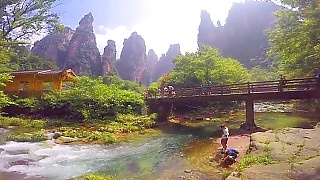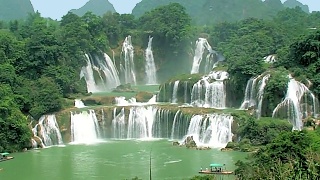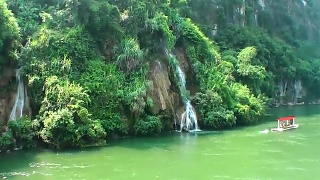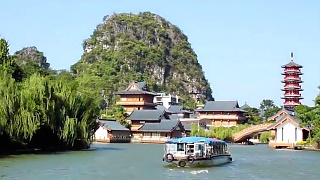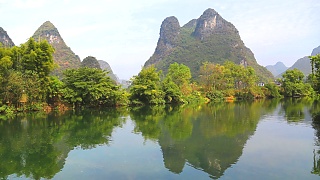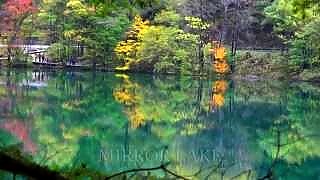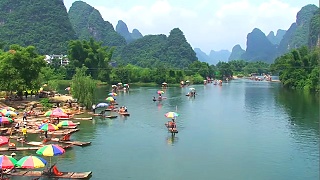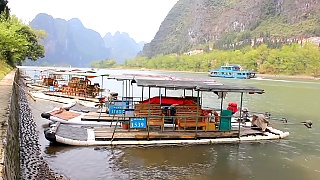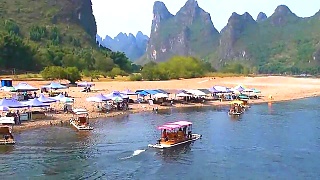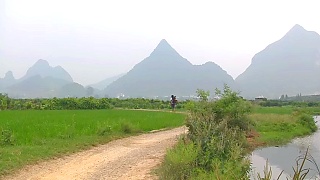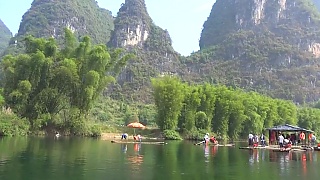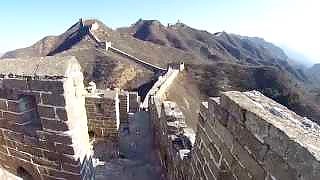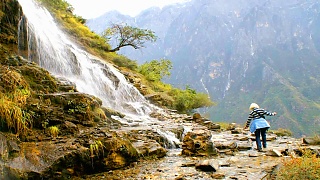With See World ...
[640],shadow=true,start=,stop=The landscape around GuiLin and the Li River is renowned for its stunning natural beauty, featuring unique karst formations, lush greenery, and picturesque waterways. This area, often celebrated in Chinese art and poetry, offers some of the most iconic scenery in China. Here are the key highlights of this beautiful region:
### Karst Mountains
1. **Unique Karst Topography**: The landscape is dominated by karst mountains, which are characterized by their steep, rugged limestone peaks. These formations were created by millions of years of erosion, resulting in a landscape that appears almost otherworldly.
2. **Famous Peaks**: Notable peaks include Elephant Trunk Hill, shaped like an elephant drinking water, and Fubo Hill, which offers panoramic views of Guilin city and the surrounding countryside.
### The Li River
3. **Li River Cruise**: The Li River (LiJiang) is famed for its breathtaking scenery. A popular activity is taking a river cruise from Guilin to Yangshuo. The cruise passes by some of the most picturesque landscapes, including towering karst peaks, bamboo groves, and traditional fishing villages.
4. **Scenic Highlights**: Key scenic spots along the river include the Nine Horse Fresco Hill, which resembles a mural of nine horses, and the Reflection of Yellow Cloth Shoal, which is famously depicted on the 20 yuan banknote.
### YangShuo
5. **Yangshuo Town**: Yangshuo, a small town located at the end of the Li River cruise, is surrounded by karst mountains and is a popular destination for tourists seeking outdoor activities such as rock climbing, cycling, and hiking.
6. **West Street**: Known as the oldest street in Yangshuo, West Street is lined with cafes, restaurants, and shops, offering a mix of traditional and modern experiences.
### Outdoor Activities
7. **Cycling and Hiking**: The countryside around Guilin and Yangshuo is ideal for cycling and hiking. Visitors can explore the scenic beauty up close by biking through rice paddies, along the river, and into the mountains.
8. **Rock Climbing**: The karst formations provide excellent opportunities for rock climbing. Yangshuo has become a hotspot for climbers from around the world.
### Rivers and Caves
9. **Yulong River**: A tributary of the Li River, the Yulong River is less crowded and offers serene, beautiful views. Rafting on bamboo rafts is a popular way to enjoy the tranquil surroundings.
10. **Caves**: The region is home to numerous caves, such as Reed Flute Cave and Silver Cave, known for their impressive stalactites and stalagmites illuminated by colorful lights.
### Cultural Heritage
11. **Traditional Villages**: Alongside the natural beauty, the area is dotted with traditional villages where visitors can experience the local culture, architecture, and way of life.
12. **Impression Sanjie Liu**: An outdoor night show directed by Zhang Yimou, set against the backdrop of the Li River and the karst mountains. It features traditional songs and dances performed by local villagers and fishermen.
### Eco-Tourism
13. **Sustainability Efforts**: There is a growing focus on eco-tourism and sustainable practices to preserve the natural beauty and cultural heritage of the region while providing meaningful experiences for visitors.
### Conclusion
The landscape around Guilin and the Li River is a masterpiece of nature, with its dramatic karst mountains, verdant valleys, and clear waters. This region offers a mix of breathtaking scenery, outdoor adventures, and cultural experiences, making it one of the most beautiful and iconic destinations in China. Whether cruising down the Li River, exploring caves, or cycling through the countryside, visitors are sure to be captivated by the serene and majestic beauty of Guilin and its surroundings.
Yangshuo, situated in Guangxi Zhuang Autonomous Region in southern China, is renowned for its breathtaking karst landscapes, serene rivers, and vibrant local culture. Here's a guide for visitors to Yangshuo:
Natural Beauty:
Karst Mountains: Yangshuo is famous for its iconic karst mountains, which rise sharply from the surrounding plains, creating a dramatic and picturesque landscape. Visitors can explore these unique limestone formations by hiking, biking, or taking boat cruises along the Li River.
Li River: The Li River, one of China's most scenic waterways, meanders through the karst mountains of Yangshuo, offering stunning vistas at every turn. A leisurely boat cruise along the Li River is a must-do activity for visitors, providing opportunities to admire the breathtaking scenery and capture iconic views of the karst peaks reflected in the water.
Yulong River: The Yulong River, a tributary of the Li River, is another picturesque waterway that flows through Yangshuo's countryside. Visitors can enjoy bamboo rafting or kayaking on the Yulong River, passing through idyllic villages, rice paddies, and bamboo groves along the way.
Outdoor Activities:
Cycling: Yangshuo is a cyclist's paradise, with scenic countryside roads and trails that wind through rice fields, orchards, and traditional villages. Renting a bicycle and exploring the surrounding countryside at a leisurely pace is a popular activity for visitors.
Rock Climbing: With its towering karst cliffs and limestone peaks, Yangshuo is a premier rock climbing destination in China. Experienced climbers and beginners alike can find suitable routes and climbing spots in the area, with options for guided tours and equipment rental available.
Cultural Experiences:
West Street: West Street (Xi Jie) is the main thoroughfare in Yangshuo's town center and a hub of activity for tourists and locals alike. Lined with shops, restaurants, cafes, and bars, West Street offers a vibrant atmosphere and is a great place to shop for souvenirs, sample local cuisine, and soak in the town's unique charm.
Impression Sanjie Liu: Directed by renowned filmmaker Zhang Yimou, Impression Sanjie Liu is a spectacular outdoor performance staged on the Li River. Featuring a cast of hundreds of performers, including local fishermen and farmers, the show combines music, dance, and light effects to showcase the natural beauty and cultural heritage of the area.
Practical Tips:
Weather: Yangshuo has a subtropical climate with mild winters and hot, humid summers. The best time to visit is during the spring (March to May) and autumn (September to November) when the weather is most pleasant and the landscapes are lush and green.
Accommodation: Yangshuo offers a range of accommodation options, including guesthouses, boutique hotels, and hostels catering to various budgets and preferences. Staying in the town center allows visitors to easily access attractions, restaurants, and transportation options.
Local Cuisine: Don't miss the opportunity to sample Yangshuo's delicious local cuisine, which includes specialties such as beer fish and Guilin rice noodles. Many restaurants in Yangshuo offer outdoor seating with panoramic views of the surrounding karst landscape.
Yangshuo's stunning natural scenery, outdoor activities, and vibrant cultural scene make it a popular destination for travelers seeking to explore the beauty of southern China. Whether cruising along the Li River, cycling through the countryside, or immersing oneself in the town's bustling street life, Yangshuo offers unforgettable experiences for visitors of all ages and interests.

 Beautiful GuiLin, GuangXi province
Beautiful GuiLin, GuangXi province
